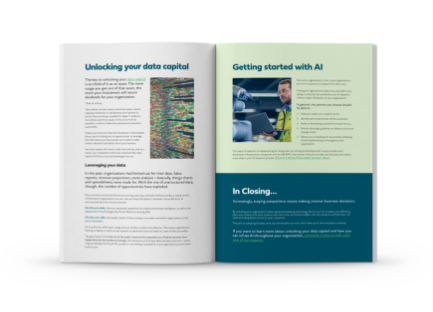BLOG
The latest in infrastructure, technology, and security
From emerging innovations to real-world applications, we cover what helps leaders navigate complexity, drive transformation, and make smarter decisions in a rapidly evolving landscape.
The CIO’s Guide to Unlocking Data Capital and Leveraging AI to Leap Ahead of the Market
Conduct a survey of contemporary CIOs, and chances are you’ll find consensus on a list of challenges they face.
These are concerns that cause them to toss and turn at night, such as:

We’re going to dive into how organizations can leverage the power of Artificial Intelligence (AI) to remedy these challenges. This includes:

Click here to download this page as a PDF to refer to later.
Download Guide as PDF
The key to unlocking your data capital is to think of it as an asset. The more usage you get out of that asset, the more your investment will return dividends for your organization.
Think of airlines …
Their planes are their assets, and those assets require ongoing investment in maintenance and systems to ensure they are always available for flight. In addition, the airlines want their assets in the air as much as possible in order to make their substantial investment worthwhile.
Unless you treat your data like the planes in the example above, you’re missing out on opportunities to leverage the information you have access to in order to make smarter decisions and better serve your business.
Your data capital will remain under lock and key, and as a result, your competitors that have unlocked their data capital will have a very real advantage over you.
In the past, organizations had limited use for their data. Sales reports, revenue projections, costs analysis—basically, things charts and spreadsheets were made for. With the rise of unstructured data, though, the number of opportunities have exploded.
More and more connected devices are arriving every day, and each of them provides a steady stream of information organizations can use. Like any major disruption in business, the proliferation of unstructured data has its pros and cons.
On the pro side, there are expanded capabilities for traditional business intelligence, as well as the deployment of technologies like AI and Machine Learning (ML).
On the con side, the steady stream of data coming in can easily overwhelm organizations to the point of paralysis.
AI, in particular, relies upon a large amount of data in order to be effective. That means organizations looking to deploy it need to have systems in place that store and make an ocean of data accessible.
The good news is that the rise of the public cloud and the expanded use of hybrid solutions have helped alleviate the burdens of storage. And advances such as data lakes and data reservoirs—pools of governed data for AI and ML to play in—are making it possible for more organizations to put those tools to use.
Once confined to imaginations of sci-fi writers, AI is now one of the fastest growing tools being put to use by organizations. This is due to there being very real and tangible benefits in the technology, including sizable increases in customer spend and decision making for organizations, as well as substantial reduction in costs from AI automation.
While new uses for AI are being unearthed every day, generally there are four ways organizations are currently using it:
Each of these can help address the concerns of CIOs mentioned at the beginning of this piece.
Automation and AI-enhanced customer service, for example, can reduce employee and customer churn. And data analysis and AI-driven internal communications can bolster an organization’s competitiveness and resource planning.

Click here to download this page as a PDF to refer to later.
Download Guide as PDF
Enterprises looking to adopt Anthos in order to utilize Kubernetes on-premises or via the hybrid cloud have a lot of hardware options.
Given the benefits of AI technology, it can be tempting for organizations to want to jump right in. This is a mistake. Yes, every organization is different, with different capabilities, but the general rule every organization should follow is first you crawl, then you walk, then you run.
Here are three critical steps you should take in order to actually realize the benefits of AI adoption:
Your first AI project should be at a scale that is achievable. Your goal is an immediate and tangible impact.
Begin by figuring out exactly what you’re trying to achieve by adopting AI, then work to get buy-in from every decision maker within your organization. Some common motivations include:
Once you’ve agreed upon which of these motivations you want to focus on first, choose a project small enough to get your feet wet but not too minor to be irrelevant to your organization.
For example, if your goal is improved customer service, deploy AI-powered chatbots on a small scale, then monitor the results.
You will need to put time and money toward your AI adoption. There will be meetings, schedules, and deadlines.
Your technology will likely need an upgrade, especially if your organization has yet to make the move to the cloud or a hybrid solution, or have limited analytics capabilities currently in place.
Among your investments should be a complete assessment of your organization’s technical maturity. You can learn more about this step in our free eBook on the Technical Maturity Framework.
For data, which is the fuel that propels your AI initiatives, you need to ensure you have the infrastructure and storage in place to capture and house all your information.
While on the whole these investments may seem substantial, they will more than be made up for by successfully incorporating AI into your daily operations.
Keep in mind that this is not a short-term investment with a quick return. But rather, an upfront cost that should continue to return on the investment for years to come.
It’s important that, once your adoption of AI is up and running, you work to identify ways it can be put to work throughout your organization.
When fully implemented, AI has the potential to benefit every department from customer service and analytics, to HR, marketing, and distribution.
As long as every segment in your organization has access (and you have protocols in place to govern what data they have access to) you’ll likely find new and unique ways to leverage the information you have with the power of AI.

Not every organization, in fact, most organizations are not in a position to adopt AI on their own.
Finding the right partner takes time and effort, but doing it correctly can accelerate your AI adoption without major disruption to your organization.
In general, any partner you choose should be able to:
Our years of expertise in implementing AI, along with our strong partnerships with cloud providers and datacenter infrastructure companies such as Dell EMC, have proven that we can help you develop and achieve every step in your AI adoption process. Give us a shout if you want to learn more.
Increasingly, staying competitive means making smarter business decisions.
By unlocking your organization’s data capital and adopting technology like AI, you can increase your efficiency, allow your teams to be more creative with their time, and unlock insights into new products and services—all while providing better service to your customers.
The path to adopting AI takes work, but the benefits can more than make up for the investment involved.
If you want to learn more about unlocking your data capital and how you can infuse AI throughout your organization, schedule a time to talk with one of our experts.